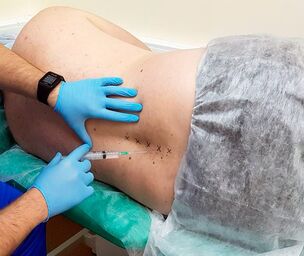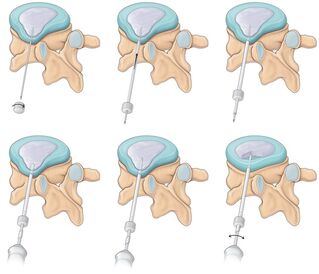According to medical statistics, acute back pain is the second most common cause of disability. At least 80% of people have suffered from them at least once. They can occur sporadically or be observed during exacerbations of spinal diseases. But in any case, acute and chronic back pain requires competent treatment and targeted action on the causes of their occurrence.
Acute back pain: causes

Acute pain is one that lasts for less than 6 weeks. For most, it disappears within 2 weeks. Although at first it is impossible to predict how long it will last. However, in almost half of the cases, similar or more severe attacks recur in the future and become chronic pain.
Acute pain can be of varying intensity, dull, burning, etc. Sometimes radiates to hands, feet, buttocks. So-called back pain often occurs after hypothermia, excessive physical exertion and as a result of spasms. Several days may pass between the influence of the traumatic factor and the direct manifestation of the pain syndrome, and it will appear under the influence of insignificant physical effort, for example, bending over.
They may also be the result of a back injury or the first manifestation of spinal diseases, including:
- osteochondrosis;
- intervertebral hernia;
- spondyloarthritis;
- spinal stenosis, etc.
Increase the likelihood of back problems:
- frequent stress;
- regular increased physical activity;
- overweight;
- frequent and prolonged stay.
In addition to severe back discomfort, headache, burning sensation in the legs, and dizziness may be present. All of these symptoms should be reported to the attending physician.
No matter which anatomical structure is damaged first, this involves a whole chain of successive changes that increase concern. Initially, inflammatory factors form in the lesion, causing swelling and irritating nerve fibers. In response to this, muscle spasm often occurs, which further aggravates the situation and provokes poor circulation in the affected area. This leads to a decrease in the amount of nutrients and oxygen that enter the focus of the lesion, as well as the retention of metabolic products in it.
Treatment of acute back pain
To relieve the pain, lie on your back on a firm surface. This will allow your back muscles to relax and relieve stress on your back. To increase the effect, orthopedic pillows can be placed below the knees and under the head, but it is important to avoid falling on the lower back. With severe pain, short-term NSAID group medications are allowed. In the future, you should definitely contact a neurologist or spine surgeon to determine the cause of the pain syndrome.
As soon as possible, you should see a doctor if there is no improvement within a week, a recurrence of an attack or radiation pain in the legs or knees, a violation of urination and defecation. To diagnose existing disorders, patients are told:
- MRI;
- CT;
- x-ray;
- biochemical blood test;
- UAC.
Based on the research results and the characteristics of the symptoms, the doctor makes a diagnosis and develops treatment tactics. In the event of acute pain depriving a person of the ability to work, he or she may be offered to perform a spinal block, which relieves the pain syndrome within minutes.
Once the discomfort has subsided, it is important not to stay in bed. Moderate physical activity, supplemented with special exercises in medical gymnastics, is the best prevention of recurrence of such attacks in the future.
When you go to the hospital, you will definitely receive high quality treatment for pain syndrome and its causes. Specialists will be able to develop the most effective treatment tactics and quickly relieve pain with the help of a well-made, affordable blockade.
Chronic back pain: causes
People suffer from chronic back pain withdrawal just as often. They can worsen and turn into an attack of acute pain, which completely extinguishes a person from the usual rhythm. Most often they are the result of:
- Sedentary lifestyle, which leads to weakening of the muscular corset. This provokes an increase in load on the spine and compression of the vertebrae. The result is osteochondrosis, elongation of intervertebral discs and intervertebral disc herniation, spondyloarthritis.
- Behavioral disorders. Long-term maintenance of any body position, in which the natural curves of the spine are disrupted, provokes its bending and the development of scoliosis or kyphosis. This includes degenerative changes in the intervertebral discs, redistribution of load on the muscles, and tightening of the nerve roots.
- Weakening of the abdominal muscles. Since they act as a support for the internal organs and partially relieve the spine when they are weak, the load on the lower back increases, which increases lordosis and provokes chronic pain. In addition to a sedentary lifestyle, weakening of the abdominal muscles can be a consequence of pregnancy or overweight.
- Age changes. Over the years, the intervertebral discs gradually dehydrate, which causes a decrease in their elasticity, strength and size. Anulus fibrosus that surrounds the nucleus like jelly dries out and becomes more brittle. Loads provoke the formation of cracks in it, which leads to the formation of extensions and hernias. The resulting outlet can squeeze the blood vessels that lie nearby, the nerve roots, the spinal cord, which provokes the onset of pain syndrome.
Chronic back pain diseases include:
- osteochondrosis;
- spondyloarthritis;
- osteoporosis;
- intervertebral hernia;
- aspect syndrome;
- ankylosing spondylitis;
- spondylolisthesis;
- rheumatoid arthritis;
- intercostal neuralgia;
- oncological diseases and others.
A common cause of chronic pain is deterioration of the facial joints. The cartilages located in them are also prone to thinning under excessive stress on the spine. As a result, when they move, they cease to perform a shock-absorbing function, which provokes friction of bone fragments and the development of inflammation.
Treatment of Back Pain
Treatment tactics are developed based on what disorders have been discovered during diagnostic studies. When spinal diseases are detected, conservative therapy is initially prescribed, including:
- drug therapy;
- physiotherapy;
- massage;
- exercise therapy.
Conservative therapy
A holistic, individualized approach is important when treating back pain. Depending on the cause of their occurrence, patients are prescribed a number of medications, in particular:
- NSAIDs - drugs in this group have anti-inflammatory and analgesic effects, but with prolonged use they adversely affect the condition of the digestive tract;
- corticosteroids - drugs with pronounced anti-inflammatory properties, prescribed in moderate to severe cases;
- muscle relaxants - help to eliminate increased muscle tone and spasms;
- antidepressants - help eliminate psychological distress, which often reduces the effectiveness of conservative therapy;
- topical agents - oils or gels containing anti-inflammatory, warming or cooling ingredients can help reduce the severity of the pain and cause virtually no side effects;
- chondroprotectors - preparations containing glucosamine and chondroitin have a beneficial effect on the condition of cartilage tissue, increase its elasticity and help restore normal thickness.

In mild cases, oral medication is sufficient. But in more complex situations, patients may prescribe injections within the article. In case of severe pain, it is recommended to make blockages once or as a whole course, which may include up to 10 procedures.
To improve the effectiveness of drug therapy, patients are prescribed massage sessions and physiotherapy. The correct effect on the back muscles helps to activate blood and lymph flow, improve metabolic processes and eliminate muscle spasms. Manual therapy is very effective for spinal deformities, especially for 1-2 degree scoliosis. Regular sessions help restore the normal position of the spine and relieve pressure on the internal organs.
As part of physiotherapy, patients are assigned sessions:
- UHF;
- magnetic therapy;
- Bernard currents;
- laser therapy;
- electrophoresis;
- UFO;
- balneological treatment.
If within six months it is not possible to improve the condition or there is a risk of complications, patients may be offered surgical treatment of existing diseases.
Surgical Treatment
Modern methods of surgical intervention are distinguished by a high level of efficiency and safety. They allow you to quickly eliminate the pathological cause of the development of pain syndrome and often do not require a hospital stay. But most minimally invasive and microsurgical methods can only be applied when patients are referred to spine surgeons in the early stages of disease development.
Indications for surgical treatment are:
- progressive hernial intervertebral discs; spinal stenosis;
- sequestered hernia;
- spinal fractures;
- grade 3-4 scoliosis;
- severe forms of spondyloarthritis;
- oppression of the spinal cord or its nerve roots;
- hemangiomas of the vertebral bodies;
- instability of individual spine segments;
- equine cauda syndrome.
The surgeon determines the type of surgery based on the severity of the patient's condition. With the same diagnosis, surgical treatment can be performed in different ways, varying in degree of invasiveness, effectiveness, duration of rehabilitation, and cost.
Recently, minimally invasive surgical treatment methods have become very popular. With their help, treatment of intervertebral extensions, intervertebral disc herniations, hemangiomas and a number of other diseases is performed. Minimally invasive surgery lasts no more than an hour and after its completion, the patient can walk almost immediately and leave the clinic the same or the next day.

The great advantages of the method are a good cosmetic effect (in most cases, all the necessary surgical instruments are inserted through soft tissue drilling), ease of rehabilitation and a bargain price. In the case of intervertebral hernias, only nucleoplasty or cold plasma hydroplasty (hydrodiscectomy) can be considered a more promising method.
In situations where microsurgical techniques cannot be applied, surgeons perform open surgeries. During them, it is possible to completely remove pathologically altered formations, level severe spinal deformities, replace irreparable structures with implants, and achieve normal spinal function by mounting titanium metal structures.
Modern spine surgery is able to deal with almost any back problem. All the latest methods of surgical treatment of back diseases are available in many institutions. A team of doctors of different profiles will help you get rid of chronic acute or excruciating back pain as soon as possible.
Preventing back pain
After the crisis and dull pain are over, it is recommended that you avoid another episode:
- do not lift very heavy objects;
- do not bend;
- walk more;
- gives up heavy physical work;
- when you sit down, take regular breaks to warm up.



































